Home video game console
A home video game console is a video game console that is designed to be connected to a display device, such as a television, and an external power source as to play video games. Home consoles are generally less powerful and customizable than personal computers, designed to have advanced graphics abilities but limited memory and storage space to keep the units affordable. While initial consoles were dedicated units with only a few games fixed into the electronic circuits of the system, most consoles since support the use of swappable game media, either through game cartridges, optical discs, or through digital distribution to internal storage.
| Part of a series on the |
| History of video games |
|---|
There have been numerous home video game consoles since the first commercial unit, the Magnavox Odyssey in 1972. Historically these consoles have been grouped into generations lasting each about five years based on common technical specifications. As of 2020, there have been eight console generations, with the current leading manufactures being Sony, Microsoft, and Nintendo; past console manufacturers have included Atari, Fairchild, Intellivision Entertainment, Coleco, Sega, NEC, 3DO, and SNK.
Overview
A home video game console is a predesigned piece of electronic hardware that is meant to be placed at a fixed location at one's home, connected to a display like a television screen or computer monitor, and to an external power source, to play video games on using one or more video game controllers. This differs from a handheld game console which will have a built-in screen, controller buttons/features, and a power supply like a battery or battery pack.
Earlier home consoles were typically built from a selection of standard and highly customized integrated computer chips, packaged onto circuit boards and cases. Over time, home console design has converged to a degree with personal computers, using similar component and system design, including standardization with main computer chip architecture. Consoles remain as fixed systems, lacking the customization options that personal computer components have, and most consoles include customized components to maximize space and reduce power consumption to provide the best performance for game playing, while lowering costs with reduced storage and memory configurations.[1]
Home video game consoles typically can play a multitude of games, offered either as game cartridges (or ROM cartridges), on optical media like CD-ROM or DVD, or obtained by digital distribution. Early consoles, also considered dedicated consoles, had games that were fixed in the electronic circuitry of the hardware. Some facets may be controlled by switching external controls on the console but the games could not be changed themselves.
Most home consoles require a separate game controller, and may support multiple controllers for multiplayer games. Some console games can only be played with special, unconventional game controllers, such as light guns for rail shooters and guitar controllers for music games. Some consoles also possess the ability to connect and interface with a particular handheld game system, which certain games can leverage to provide alternate control schemes, second screen gameplay elements, exclusive unlockable content or the ability to transfer certain game data.
History
The first commercial video game console was the Magnavox Odyssey, developed by Ralph H. Baer and first released commercially in 1972. It was shortly followed by the release of the home version of Pong by Atari Inc. in 1975 based on the arcade game. A number of clones of both systems rushed to fill the nascent home console market and the video game industry suffered a small recession in 1977 due to this.
The Fairchild Channel F, released in 1976, was the first console to use game cartridges, which was then used by the Atari VCS and several other consoles of the second generation and led to a second boom in the video game industry in the United States and around the globe. During this time, Atari Inc. had been sold to Warner Communications, and due to a change of leadership, several programmers left the company and founded Activision, becoming the first third-party developer. Activision's success led to a rush of new developers creating games without any publishing controls for these systems. The market became flooded with poor quality games, and combined with the rising popularity of the personal computer and the economic recession of the early 1980s, led to the video game crash of 1983 in the U.S. market. Nintendo, which had released its Famicom console in Japan that year, took several cautionary steps to limit game production to only licensed games, and was able to introduce the Famicom, rebranded as the Nintendo Entertainment System (NES) in 1985 into the U.S. marker. The NES helped to revive the console market and gave Nintendo dominance during the late 1980s.
Sega took advantage of the newfound U.S. growth to market its Sega Genesis against the Super Nintendo Entertainment System in the early 1990s in the so-called "console wars" and emphasized the notion of "bits" as a major selling point for consumers. The consumer adoption of optical discs with larger storage capacity in the mid-1995 led many console manufactures to move away from cartridges to CD-ROMs and later to DVDs and other formats, with Sony's PlayStation line introducing even more features that gave it an advantage in the market; the PlayStation 2, released in 2000, remains the best-selling console to date with over 155 million units sold. Microsoft, fearing that the PlayStation 2 was threatening the competitive edge of the personal computer, entered the console space with its Xbox line in 2001. Internet connectivity had become commonplace by the mid-2000s, and nearly all home consoles supported digital distribution and online service offerings by the 2010s.
With Sony and Microsoft's dominance in hardware capabilities, most other major manufacturers have since dropped out of the hardware business, but maintain a presence in the game development and licensing space. Nintendo remains the only competitor having taken a blue ocean strategy by offering more original console concepts such as motion sensing in the Wii and the hybrid design of the Nintendo Switch.
Timeline overview
Below is a timeline of each generation with the top three home video consoles of each generation based on worldwide sales. For a complete list of home video consoles released in each generation please see the respective article of each generation.
# | Current | A current-generation console being manufactured and sold on the market. |
† | First place | Home console with the highest sales of its generation. |
‡ | Second place | Home console with the second highest sales of its generation. |
◁ | Third place | Home console with the third highest sales of its generation. |
| Remaining places | Manufacturer released a home console but it was not one of the top three best-selling home consoles of its generation. | |
| No entry | Manufacturer did not release a home console. |
| Manufacturer | Generation | Ref(s) | |||||||
|---|---|---|---|---|---|---|---|---|---|
| First (1972–1980) |
Second (1976–1992) |
Third (1983–2003) |
Fourth (1987–2004) |
Fifth (1993–2006) |
Sixth (1998–2013) |
Seventh (2005–2017) |
Eighth (2012–present) | ||
| Atari | Home Pong (150,000) |
Atari 2600 † (30 million)[note 1] |
Atari 7800 ◁ (1 million)[note 2] |
Atari Jaguar (250,000) |
[note 3] | ||||
| Coleco | Telstar (1 million) |
ColecoVision ◁ (2+ million) |
[note 4] | ||||||
| Nintendo | Color TV-Game series (1.5 million) |
NES † (61.91 million) |
Super NES † (49.1 million) |
Nintendo 64 ‡ (32.93 million) |
GameCube ◁ (21.74 million) |
Wii † (101.63 million) |
Nintendo Switch ‡ # (61.44 million)[note 5] |
[note 6] | |
| Magnavox/ Philips |
Odyssey (330,000) |
Odyssey² (2 million) |
Videopac + G7400 (N/A) |
CD-i (570,000) |
|||||
| Mattel | Intellivision ‡ (3 million) |
HyperScan (N/A) |
[note 8] | ||||||
| Sega | Master System ‡ (10–13 million)[note 9] |
Sega Genesis ‡ (33.75 million) |
Sega Saturn ◁ (9.26 million) |
Dreamcast (9.13 million) |
[note 10] | ||||
| NEC | TurboGrafx-16 ◁ (10 million) |
PC-FX (100,000) |
[note 11] | ||||||
| Sony | PlayStation † (102.49 million) |
PlayStation 2 † (>155 million) |
PlayStation 3 ‡ (>87.4 million) |
PlayStation 4 † # (108.9 million) |
[note 12] | ||||
| Microsoft | Xbox ‡ (>24 million) |
Xbox 360 ◁ (>84 million) |
Xbox One ◁ # (est. 46.9 million) |
[note 13] | |||||
> Final sales are greater than the reported figure. See notes.
List of home video game consoles
There are approximately 1000 home video game consoles known to exist, the vast majority of which were released during the first generation: only 100 home video game consoles were released between the second and current generation, 10 were canceled . This list is divided into console generations which are named based on the dominant console type of the era, though not all consoles of those eras are of the same type. Some eras are referred to based on how many bits a major console could process. The "128-bit era" (sixth generation) was the final era in which this practice was widespread.
This list only counts the first iteration of each console's hardware, because several systems have had slim, enhanced or other hardware revisions, but they aren't individually listed here. The list also includes unreleased systems. If a series of home video game consoles begins in a generation and lasts to another generation, it is listed in the generation the series began. This list does not claim to be complete.
This list does not include other types of video game consoles such as handheld game consoles, which are usually of lower computational power than home consoles due to their smaller size, microconsoles, which are usually low-cost Android-based devices that rely on downloading, retro style consoles, or dedicated consoles past the first generation, which have games built in and do not use any form of physical media. Consoles have been redesigned from time to time to improve their market appeal. Redesigned models are not listed on their own.
- Background shading indicates canceled systems that either stopped being developed at any stage or were canceled.
- # Hash-tags indicate console series/platforms that have different hardware revisions.
First generation (1972–1984)
There are more than 900 home video game consoles known to have been released in the first generation of video game consoles. They can be found in the list of first generation home video game consoles in which 902 of them are listed.
Most consoles of this generation were dedicated consoles with games built into the electronic circuitry of the hardware. Players could use switches on the console or similar external methods to "switch" games, but could not add new game functionality to the console.
Second generation (1976–1992)
There were a total of 21 home video game consoles released in the second generation, and 1 cancelled platform;
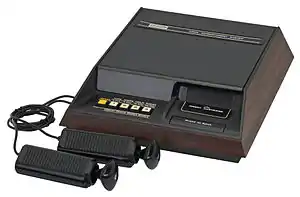 Fairchild Channel F (November 1976)
Fairchild Channel F (November 1976)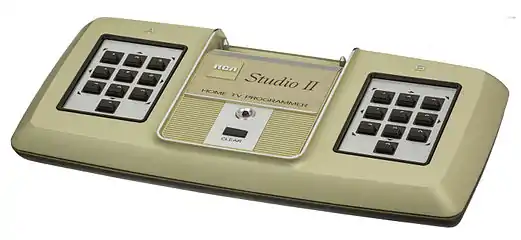 RCA Studio II (January 1977)
RCA Studio II (January 1977)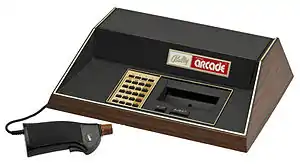 Bally Astrocade (1977)
Bally Astrocade (1977)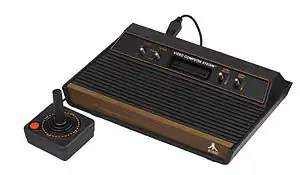 Atari 2600 (1977)
Atari 2600 (1977) APF-MP1000 (1978)
APF-MP1000 (1978) Interton VC 4000 (1978)
Interton VC 4000 (1978)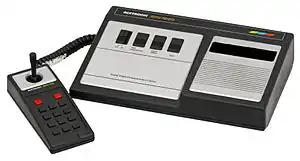
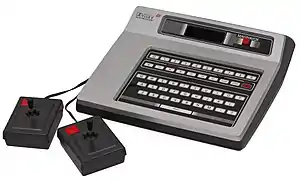 Magnavox Odyssey 2 (1978)
Magnavox Odyssey 2 (1978)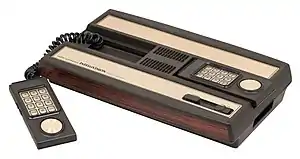 Intellivision (1980)
Intellivision (1980)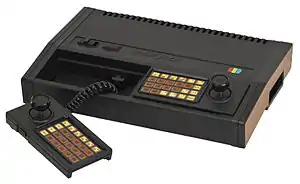 VTech CreatiVision (1981)
VTech CreatiVision (1981)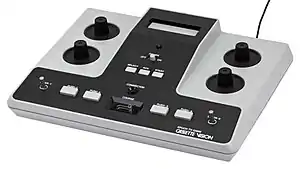 Epoch Cassette Vision (1981)
Epoch Cassette Vision (1981)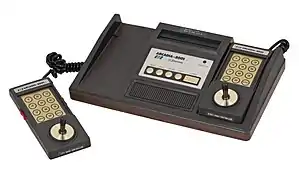 Arcadia 2001 (1982)
Arcadia 2001 (1982)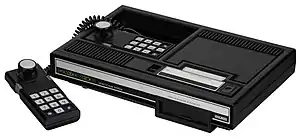 ColecoVision (1982)
ColecoVision (1982) Atari 5200 (1982)
Atari 5200 (1982)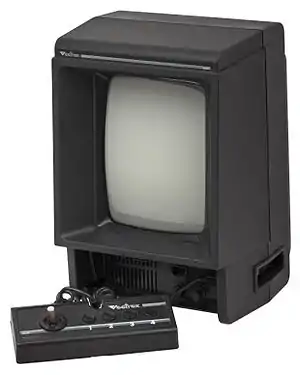 Vectrex (1982)
Vectrex (1982)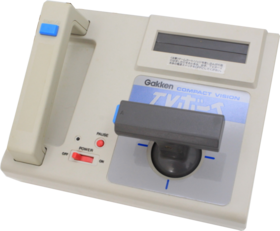 Gakken Compact Vision TV Boy (1983)
Gakken Compact Vision TV Boy (1983)
| Name | Release date | Manufacturer | Units sold |
|---|---|---|---|
| Fairchild Channel F # | November 1976 | Fairchild (U.S.) | ca. 250,000 |
| RCA Studio II | January 1977 | RCA (U.S.) | ? |
| Bally Astrocade | 1977 | Midway (U.S.) | |
| Atari 2600 # | September 11, 1977 | Atari Inc. (U.S.) | ca. 30 million[4] |
| APF-MP1000 | January 1, 1978 | APF (U.S.) | ? |
| Champion 2711 | 1978 | Unisonic (U.S.) | |
| Interton VC 4000 | Interton (Germany) | ||
| Palladium Tele-Cassetten Game | Palladium (Germany) | ||
| 1292 Advanced Programmable Video System | Audiosonic | ||
| Magnavox Odyssey 2 | December 1978 | Magnavox (U.S.) / Philips (Netherlands) | |
| APF Imagination Machine | 1979 | APF (U.S.) | |
| Bandai Super Vision 8000 | Bandai (Japan) | ||
| Intellivision # | 1980 | Mattel (U.S.) | >3 million |
| VTech CreatiVision | 1981 | VTech (Hong Kong) | ? |
| Epoch Cassette Vision # | July 30, 1981 | Epoch (Japan) | |
| Arcadia 2001 and its variants and clones | 1982 (Arcadia 2001) | Emerson Radio (U.S.) | |
| SHG Black Point | 1982 | Süddeutsche Elektro-Hausgeräte GmbH & Co. KG (Germany) | |
| ColecoVision | August 1982 | Coleco (U.S.) | ca. 2 million |
| Atari 5200 | November 1982 | Atari Inc. (U.S.) | ca. 1 million |
| Vectrex | November 1982 | GCE/Milton Bradley Company (U.S.) | ? |
| Compact Vision TV Boy | October 1983 | Gakken (Japan) | |
| Video Arcade System | Cancelled (supposed to be released in 1983) | Ultravision (U.S.) | 0 |
Third generation (1983–2003)
There were a total of 23 home video game consoles released in the third generation, and 3 cancelled platforms;
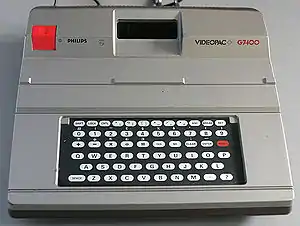 Videopac+ G7400 (1983)
Videopac+ G7400 (1983) My Vision (1983)
My Vision (1983)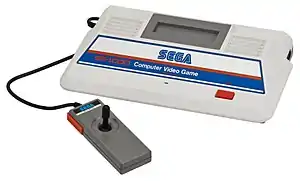 Sega SG-1000 (1983)
Sega SG-1000 (1983) Nintendo Family Computer (1983)
Nintendo Family Computer (1983)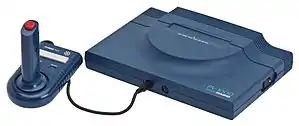 PV-1000 (1983)
PV-1000 (1983)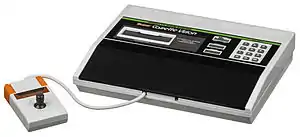 Super Cassette Vision (1984)
Super Cassette Vision (1984)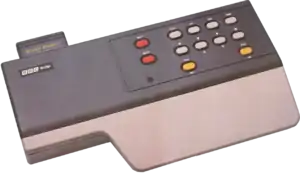 BBC Bridge Companion (1985)
BBC Bridge Companion (1985)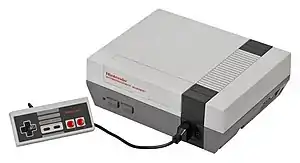
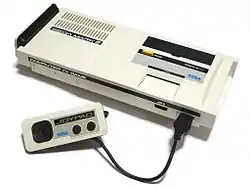 Sega Mark III (1985)
Sega Mark III (1985)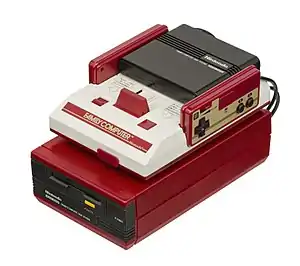 Family Computer Disk System (1986)
Family Computer Disk System (1986)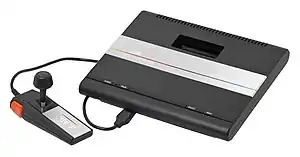 Atari 7800 (1986)
Atari 7800 (1986)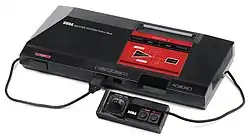 Sega Master System (1986)
Sega Master System (1986)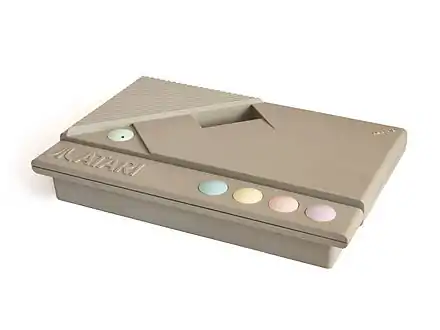 Atari XEGS (1987)
Atari XEGS (1987) Action Max (1987)
Action Max (1987)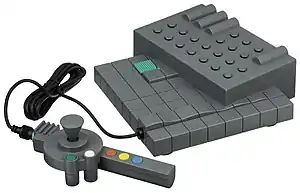
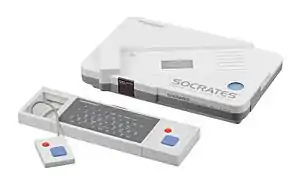 VTech Socrates (1988)
VTech Socrates (1988)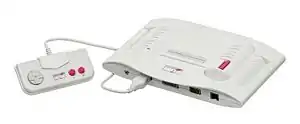 Amstrad GX4000 (1990)
Amstrad GX4000 (1990) Commodore 64 Games System (1990)
Commodore 64 Games System (1990)
| Name | Release date | Manufacturer | Units sold | CPU | "Bits" |
|---|---|---|---|---|---|
| Videopac+ G7400 | 1983 | Philips (Netherlands) | ? | Intel 8048 @ 5.91 MHz | 8-bit |
| My Vision | Nichibutsu (Japan) | ? | |||
| Pyuuta Jr. | April 1983 | Tomy (Japan) | |||
| Sega SG-1000 # | July 15, 1983 | Sega (Japan) | ca. 2 million | Zilog Z80 @ 3.58 MHz | |
| NES/Family Computer (Famicom) # | July 15, 1983 | Nintendo (Japan) | ca. 61.91 million | Ricoh 2A03 processor (MOS Technology 6502 core) | 8-bit |
| PV-1000 | October 1983 | Casio (Japan) | ? | Z80A clocked at 3.579 MHz | 8-bit |
| Epoch Super Cassette Vision | July 17, 1984 | Epoch (Japan) | 400,000 | NEC PD7801G | |
| Bridge Companion | 1985 | BBC/Heber (UK) | ? | Zilog Z80 | |
| Video Art | LJN (U.S.) | ? | |||
| Zemmix # | Daewoo Electronics (South Korea) | Zilog Z80 | 8-bit | ||
| Sega Mark III/Sega Master System # | October 20, 1985 | Sega (Japan), Tec Toy (Brazil) | ca. 13 million | Zilog Z80 @ 4 MHz | |
| Family Computer Disk System[50] | February 21, 1986 | Nintendo (Japan) | ca. 4.44 million | Ricoh 2A03 processor (MOS Technology 6502 core) | |
| Videosmarts[51] | 1986 | Connor Electronics (U.S.) (1986–1988), VTech (Hong Kong) (1989–1990) | ? | ? | ? |
| Atari 7800 | May 1986 | Atari Corporation (U.S.) | 8-bit | ||
| Atari XEGS | 1987 | Atari Corporation (U.S.) | ca. 2 million | MOS Technology 6502C | |
| Video Challenger | Tomy/Bandai (Japan) | ? | ? | ||
| Action Max | Worlds of Wonder (U.S.) | HD401010 | 8-bit | ||
| View-Master Interactive Vision | 1988 | View-Master Ideal Group, Inc. (U.S.) | ? | ||
| Terebikko | Bandai (Japan) | ? | |||
| VTech Socrates | VTech (Hong Kong) | 8-bit | |||
| Video Driver | October 1988[52] | Sega (Japan) | ? | ||
| Amstrad GX4000 | September 1990 | Amstrad (UK) | ca. 15,000 | Zilog Z80 @ 4 MHz | 8-bit |
| Commodore 64 Games System | December 1990 | Commodore (Canada) | ? | MOS Technology 8500 @ 0.985 MHz | |
| RDI Halcyon | cancelled (supposed to be released in January 1985) | RDI Video Systems (U.S.) | 0 (<12 units are known to exist) | Zilog Z80 | ? |
| Control-Vision | cancelled (supposed to be released in 1989) | Digital Pictures & Hasbro (U.S.) | 0 | ? | ? |
| Кроха[53] | cancelled (supposed to be released in 1990) | SKB Kontur (СКБ Контур) (Russia) | 0 (~200 units were given out to manufacturer employees) | K580VM80A 2 MHz | ? |
- The Videopac+ G7400 was planned to be released in America as the Odyssey³ Command Center, with a different case design, but it never occurred, although some prototypes exist.
- Although fully developed, functional, and with 2 games ready, the few Halcyon units that exist were handmade for investors of the company to try out the product, it is not believed that it ever went into full production or entered the market at all. Less than 12 main control units (Halcyon 200LD, the console itself) are known to exist, but more Halcyon branded Laserdisc players (LD-700, made by Pioneer) exist.
- The Кроха (Read as "Krokha", meaning "Baby") was a Soviet console that was ready to launch, but production halted, only one game was made, and the approximately 200 consoles were given out to employees of the factory that manufactured it.
Fourth generation (1987–2004)
There were a total of 17 home video game consoles released in the fourth generation, and 4 cancelled platforms;
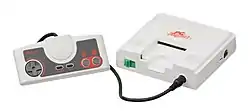 PC Engine (1987)
PC Engine (1987) Sega Genesis (1988)
Sega Genesis (1988)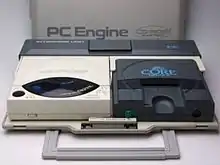 CD-ROM², First console to use CD technology. (1988)
CD-ROM², First console to use CD technology. (1988)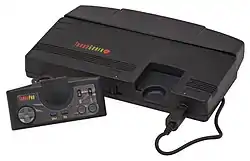 TurboGrafx-16 (1989)
TurboGrafx-16 (1989)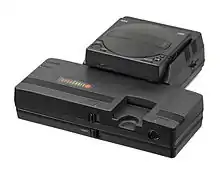 TurboGrafx-CD (1989)
TurboGrafx-CD (1989)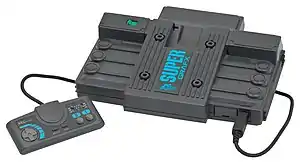 PC Engine SuperGrafx (1989)
PC Engine SuperGrafx (1989) Neo-Geo AES (1990)
Neo-Geo AES (1990)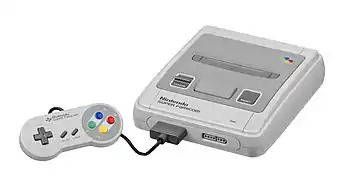 Super Famicom (1990)
Super Famicom (1990) Commodore CDTV (1991)
Commodore CDTV (1991)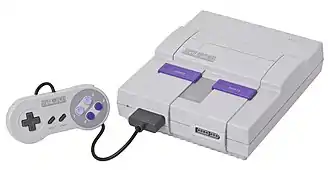
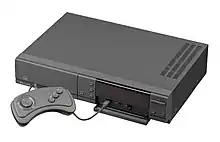 CD-i (1991)
CD-i (1991)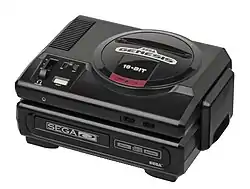 Sega CD (1991)
Sega CD (1991)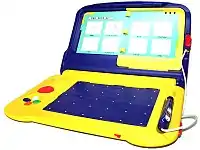 Sega Pico (1993)
Sega Pico (1993)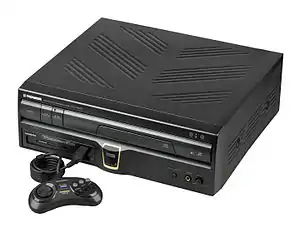 Pioneer LaserActive (1993)
Pioneer LaserActive (1993)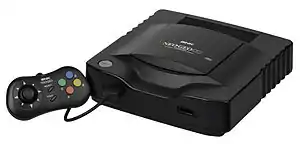 Neo-Geo CD (1994)
Neo-Geo CD (1994)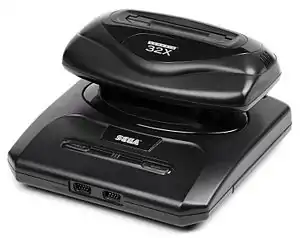 Sega 32X (1994)
Sega 32X (1994)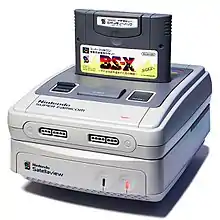 Satellaview (1995)
Satellaview (1995) Super A'Can (1995)
Super A'Can (1995)
| Name | Release date | Manufacturer | Units sold | CPU | "Bits" |
|---|---|---|---|---|---|
| PC Engine/TurboGrafx-16 # | October 30, 1987 | NEC (Japan) | ca. 10 million | Hudson Soft HuC6280 | 16-bit (8-bit CPU, 16-bit graphics) |
| Sega Genesis/Mega Drive # | October 29, 1988 | Sega (Japan) | ca. 35.25 million | Motorola 68000 @ 7.6 MHz, Zilog Z80 @ 3.58 MHz | 16-bit (16/32 bit processor, 16 bit graphics) |
| TurboGrafx-CD/CD-ROM² # | December 4, 1988 | NEC (Japan) | ? | ? | 16-bit (8-bit processor, 16-bit graphics) |
| PC Engine2/SuperGrafx | December 8, 1989 | NEC (Japan) | Hudson Soft HuC6280 | 16-bit (8-bit CPU, 16-bit graphics) | |
| Neo-Geo AES | April 26, 1990 | SNK (Japan) | ca. 750,000 | Motorola 68000 @ 12 MHz, Zilog Z80A @ 4 MHz | 24-bit (16/32 bit processor, 24 bit graphics) |
| Super NES/Super Famicom # | November 21, 1990 | Nintendo (Japan) | ca. 49.1 million | Ricoh 5A22 @ 3.58 MHz | 16-bit |
| Commodore CDTV | March 1991 | Commodore (Canada) | ? | Motorola 68000 @ 7 MHz | 16-bit |
| CD-i # | December 3, 1991 | Various | ca. 1.5 million | Philips SCC68070 @ 15.5 MHz | 16-bit (could be upgraded to 32-bit) |
| Sega CD/Mega CD # | December 12, 1991 | Sega (Japan) | ca. 2.24 million | Motorola 68000 @ 12.5 MHz | 16-bit (16/32 bit processor, 16 bit graphics) |
| Memorex VIS | June 1992 | Memorex/Tandy Corp (U.S.) | ca. 15,000 | Intel 80286 @ 12 MHz | 16-bit |
| Sega Pico | June 26, 1993 | Sega/Majesco Entertainment (Japan) | ? | Motorola 68000 @ 7.6 MHz, Zilog Z80 @ 3.58 MHz | |
| Picno | 1992[54] | Konami(Japan) | ? | ||
| Pioneer LaserActive | August 20, 1993 | Pioneer Corporation (Japan) | |||
| Neo-Geo CD # | September 9, 1994 | SNK (Japan) | Motorola 68000 @ 12 MHz, Zilog Z80 @ 4 MHz | ||
| Sega 32X | November 21, 1994 | Sega (Japan) | 800,000 | 2 × SH-2 32-bit RISC @ 23 MHz | 32-bit |
| Satellaview | April 23, 1995 | Nintendo (Japan) | ? | ? | 16-bit |
| Super A'Can | October 25, 1995 | Funtech (Taiwan) | Motorola 68000 @ 10.738635 MHz | ||
| Konix Multisystem | cancelled (supposed to be released in August 1989) | Konix (UK) | 0 | ? | 16-bit |
| Atari Panther | cancelled (supposed to be released in 1991) | Atari Corporation (U.S.) | Motorola 68000 | 32-bit | |
| WOWOW[55] | cancelled (supposed to be released in 1992) | Taito (Japan) | ? | ? | |
| SNES-CD | cancelled (development stopped in 1993) | Nintendo (Japan) | 16-bit | ||
- SNK created the Neo Geo CD as a much cheaper alternative to the AES, lowering the price of games considerably, from ~300$ to ~50$ . It's essentially an AES console with a media format change from cartridges to CDs, placing it in the fourth generation.
Fifth generation (1993–2005)
There were a total of 14 home video game consoles released in the fifth generation;
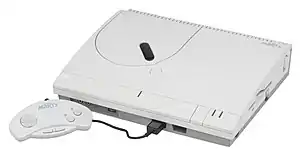 FM Towns Marty (1993)
FM Towns Marty (1993) Amiga CD32 (1993)
Amiga CD32 (1993)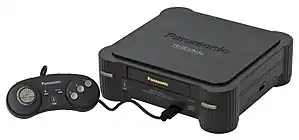 3DO Interactive Multiplayer (1993)
3DO Interactive Multiplayer (1993)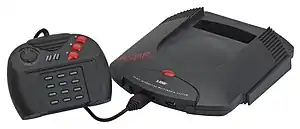 Atari Jaguar (1993)
Atari Jaguar (1993)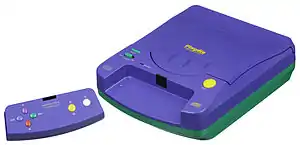 Bandai Playdia (1994)
Bandai Playdia (1994)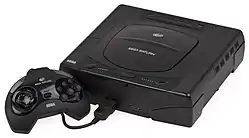 Sega Saturn (1994)
Sega Saturn (1994) Sony PlayStation (1994)
Sony PlayStation (1994)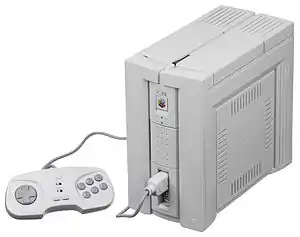 PC-FX (1994)
PC-FX (1994)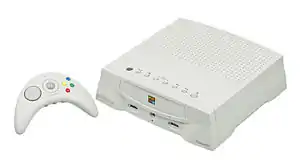 Apple Bandai Pippin (1995)
Apple Bandai Pippin (1995) Atari Jaguar CD (1995)
Atari Jaguar CD (1995)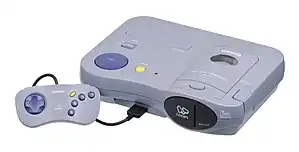 Casio Loopy (1995)
Casio Loopy (1995)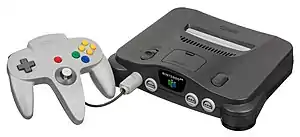 Nintendo 64 (1996)
Nintendo 64 (1996)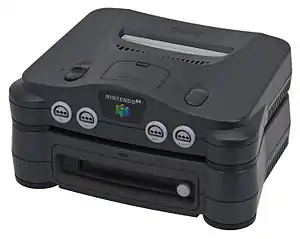 Nintendo 64DD (1999)
Nintendo 64DD (1999)
| Name | Release date | Manufacturer | Units sold | CPU | "Bits" |
|---|---|---|---|---|---|
| FM Towns Marty # | February 20, 1993 | Fujitsu (Japan) | >45,000 | AMD 386SX at 16 MHz | 32-bit |
| Amiga CD32 | September 17, 1993 | Commodore (Canada) | >100,000 | Motorola 68EC020@ 14.18 MHz (PAL) 14.32 MHz (NTSC) | |
| 3DO Interactive Multiplayer # | October 4, 1993 | Panasonic/Sanyo (Japan)/GoldStar (South Korea) | 2 million | RISC CPU ARM60 based on ARM architecture @ 12.5 MHz | |
| Atari Jaguar | November 23, 1993 | Atari Corporation (U.S.) | <250,000[56][57] | Motorola 68000 @ 13.295 MHz, Custom 32-bit graphics RISC "Tom" @ 26.59 MHz, Custom 32-bit sound RISC "Jerry" @ 26.59 MHz | 64-bit (64-bit graphics, 32-bit processor) |
| CPS Changer | 1994 | Capcom (Japan) | ? | Motorola 68000 @ 10 MHz | 16-bit |
| Playdia | September 23, 1994 | Bandai (Japan) | Toshiba TMP87C800F | 8-bit | |
| Sega Saturn # | November 22, 1994 | Sega (Japan) | 9.26 million | 2× Hitachi SH-2 @ 28.6 MHz | 32-bit |
| Sony PlayStation # | December 3, 1994 | Sony (Japan) | 102.49 million | R3000 @ 33.8688 MHz | 32-bit |
| PC-FX | December 23, 1994 | NEC (Japan) | >400,000 | NEC V810 | 32-bit |
| Apple Bandai Pippin | March 28, 1995 | Bandai (Japan)/Apple Inc. (U.S.) | 42,000 | PowerPC 603 RISC (66 MHz) | |
| Atari Jaguar CD | September 21, 1995 | Atari Corporation (U.S.) | ? | ? | 64-bit (uses Jaguar processors) |
| Casio Loopy | October 19, 1995 | Casio (Japan) | RISC SH-1 (SH7021) | 32-bit | |
| Nintendo 64 | June 23, 1996 | Nintendo (Japan) | 32.93 million | NEC VR4300 @ 93.75 MHz | 64-bit |
| Nintendo 64DD | December 1, 1999 | >15,000 | ? | 64-bit (uses N64 processor) | |
Sixth generation (1998–2013)
There were a total of 8 home video game consoles released in the sixth generation, and 2 cancelled platforms;
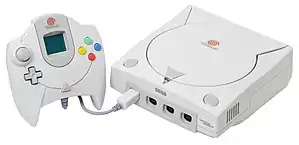 Dreamcast (1998 in Japan, 1999 in other areas)
Dreamcast (1998 in Japan, 1999 in other areas)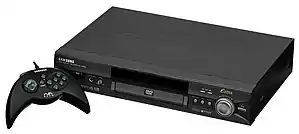 Nuon (2000)
Nuon (2000) PlayStation 2 (2000)
PlayStation 2 (2000)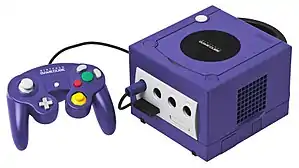 Nintendo GameCube (2001)
Nintendo GameCube (2001) Xbox (2001)
Xbox (2001)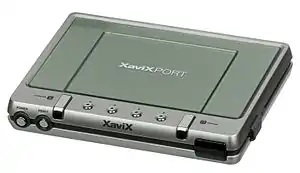 Xavix PORT (2004)
Xavix PORT (2004)
| Name | Release date | Manufacturer | Units sold | CPU | "Bits" |
|---|---|---|---|---|---|
| Dreamcast | November 27, 1998 | Sega (Japan) | ca. 9.13 million | Hitachi SH-4 32-bit RISC @ 200 MHz | 128-bit (32-bit processor, 128-bit graphics) |
| Nuon # | 2000 | VM Labs (U.S.) | >25,000 | Nuon MPE hybrid stack processor | 128-bit (SIMD) |
| PlayStation 2 # | March 4, 2000 | Sony (Japan) | ca
155 million |
Emotion Engine @ 294.912 MHz (launch), 299 MHz (newer models) | 128-bit (SIMD) |
| Nintendo GameCube # | November 14, 2001 | Nintendo (Japan) | ca. 21.74 million | IBM PowerPC Gekko @ 486 MHz | 128-bit (SIMD) |
| Xbox | November 15, 2001 | Microsoft (U.S.) | ca. 24 million | Custom 733 MHz Intel Pentium III "Coppermine-based" processor | |
| DVD Kids | 2002 | 3-Plus (Iceland)[58] | ? | ? | ? |
| Xavix PORT | 2004 | SSD COMPANY LIMITED (Japan) | 8-bit,16-bit and 32-bit (depending on game cartridge) | ||
| Advanced Pico Beena # | 2005 | Sega (Japan) | ca. 350,000 | ARM7TDMI clocked at 81 MHz | ? |
| L600 | cancelled (development stopped in April 2001) | Indrema | 0 | x86 @ 600 MHz | 32-bit |
| Panasonic M2 | cancelled (supposed to be released in 1997) | Panasonic (Japan) | Dual PowerPC 602 Processors @ 66 MHz | 64-bit (dual 32-bit) | |
Seventh generation (2005–2017)
There were a total of 7 home video game consoles released in the seventh generation, and 1 cancelled platform;
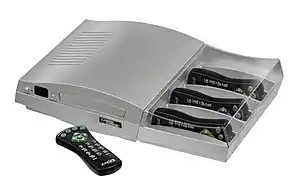
 Xbox 360 (2005)
Xbox 360 (2005) HyperScan (2006)
HyperScan (2006)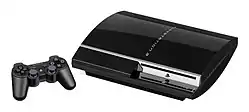 PlayStation 3 (2006)
PlayStation 3 (2006) Wii (2006)
Wii (2006) Zeebo (2009)
Zeebo (2009)
| Console / Series | Release date / Lifespan of the series | Manufacturer / Country | Units sold | CPU |
|---|---|---|---|---|
| Game Wave Family Entertainment System | October 2005 | ZAPiT (Canada) | ca. 70,000 (as of 2008)[59] | ? |
| Xbox 360 # | November 22, 2005 | Microsoft (U.S.) | ca. 85,8 million (as of December 17, 2018)[60][61][62][63] | Big-endian architecture 3.2 GHz PowerPC Tri-Core Xenon |
| V.Flash | September 2006 | VTech (Hong Kong) | ? | |
| HyperScan | October 23, 2006 | Mattel (U.S.) | ||
| PlayStation 3 # | November 11, 2006 | Sony (Japan) | ca. 86,9 million[64] | 3.2 GHz Cell Broadband Engine with 1 PPE & 7 SPEs |
| Wii # | November 19, 2006 | Nintendo (Japan) | ca. 101.63 million (as of December 31, 2016)[65] | PowerPC 750-based IBM PowerPC "Broadway" @ 729 MHz; 2.9 GFLOPS |
| Zeebo | May 25, 2009 | Zeebo Inc. (U.S.) | ? | |
| Phantom | cancelled (supposed to be released in September 2005) | Phantom (U.S.) | 0 | ? |
Eighth generation (2012–present)
There are 4 main home video game consoles released in the current generation; a number of microconsoles were also released in this generation that are not listed here.
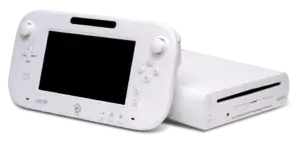 Wii U (2012)
Wii U (2012)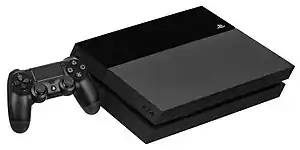 PlayStation 4 (2013)
PlayStation 4 (2013)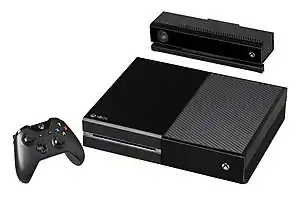 Xbox One (2013)
Xbox One (2013)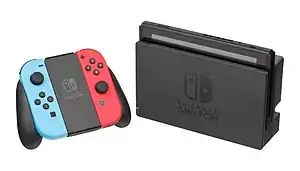 Nintendo Switch (2017)
Nintendo Switch (2017)
| Name | Release date | Manufacturer | Units sold | CPU |
|---|---|---|---|---|
| Wii U | November 18, 2012 | Nintendo (Japan) | ca. 13.56 million (as of December 31, 2016)[66] | PowerPC 750-based 1.24 GHz Tri-Core IBM PowerPC "Espresso" |
| PlayStation 4 # | November 15, 2013 | Sony (Japan) | >106 million (as of December 31, 2019)[67] | Semi-custom 8-core AMD x86-64 Jaguar 1.6 GHz CPU (integrated into APU) |
| Xbox One # | November 22, 2013 | Microsoft (U.S.) | >41 million (as of 2018)[68][lower-alpha 1] | Custom 1.75 GHz AMD 8-core APU (2 quad-core Jaguar modules) |
| Nintendo Switch # | March 3, 2017 | Nintendo (Japan) | ca. 68.30 million (as of September 30, 2020)[73] | Octa-core (4×ARM Cortex-A57 & 4×ARM Cortex-A53) @ 1.020 GHz |
- The Nintendo Switch was released during this period, but has been referred to as a hybrid video game console, combining features of home and handheld systems. This is why the Switch appears in both the list of home video game consoles and the list of handheld game consoles.
Ninth generation (2020–present)
The following are the latest home console models.
| Name | Release date | Manufacturer | Units sold | CPU |
|---|---|---|---|---|
| Xbox Series X/S | November 10, 2020 | Microsoft (U.S.) | ca. 3,500,000 (as of December 31, 2021)[74][lower-alpha 1] | |
| PlayStation 5 | November 12, 2020 | Sony (Japan) | 4,500,000 (as of December 31, 2020)[77] | Custom 8-core AMD Zen 2, variable frequency, up to 3.5 GHz[78] |
See also
Notes
- The Atari 2600 sold 30 million units during its life-cycle. Atari also released a second home console during the second generation known as the Atari 5200 which sold 1 million units.
- The Atari 7800 sold 1 million units. Atari also released the Atari XEGS during the third generation which sold 100,000 units.
- Home Pong sold 150,000 units.[2][3] Atari 2600 sold 30 million,[4] Atari 5200 and Atari 7800 sold 1 million units each[5][6] Atari XEGS sold 100,000 units,[7] and the Atari Jaguar sold 250,000 units.[8]
-
- Telestar: Coleco launched Telstar in 1976 and sold a million. Production and delivery issues, and dedicated consoles being replaced by electronic handheld games dramatically reduced sales in 1977. Over a million Telstars were scrapped in 1978, and it cost Coleco $22.3 million that year[9]—almost bankrupting the company.[10]
- ColecoVision:The ColecoVision reached 2 million units sold by the spring of 1984. Console quarterly sales dramatically decreased at this time, but it continued to sell modestly[11][9] with most inventory gone by October 1985.[12]
- As of October, 2020 the Nintendo Switch has sold 61.44 million units.[13] Nintendo also released the Wii U during the eighth generation which sold 13.56 million units during its lifecycle.[13]
- Color TV-Game series sold 3 million units.[14] NES, Super NES, Nintendo 64, GameCube and Wii sales figures.[15] Wii U and Switch sales figures.[13]
- Intellivision sold 3 million units.[19]
- The Sega Master System sold 10–13 million units. Sega also released the SG-1000 during the third generation which sold 160,000 units.
-
- Master System: 10–13 million, not including recent Brazil sales figures.[20][21] Screen Digest wrote in a 1995 publication that the Master System's active installed user base in Western Europe peaked at 6.25 million in 1993. Those countries that peaked are France at 1.6 million, Germany at 700 thousand, the Netherlands at 200 thousand, Spain at 550 thousand, the United Kingdom at 1.35 million, and other Western European countries at 1.4 million. However, Belgium peaked in 1991 with 600 thousand, and Italy in 1992 with 400 thousand. Thus it is estimated approximately 6.8 million units were purchased in this part of Europe.[22] 1 million were sold in Japan as of 1986.[23] 2 million were sold in the United States.[24] 8 million were sold by Tectoy in Brazil as of 2016.[25]
- Sega Genesis: 30.75 million sold by Sega worldwide as of March 1996,[26][27] not including third-party sales. In addition, Tec Toy sold 3 million in Brazil,[28][29] and Majesco Entertainment projected it would sell 1.5 million in the United States.[30]
- Sega Saturn: 9.26 million units sold.[27]
- Dreamcast: 9.13 million units sold.[27][31][32][33]
- The TurboGrafx-16 was designed by Hudson and manufactured and marketed by NEC.[34] The TurboGrafx-16 managed to sell 10 million units.[35] The PC-FX sold less than 100,000 after a year on sale.[36]
- PlayStation: Sony corporate data reports 102.49 million units sold as of March 31, 2007.[37] Sony stopped divulging individual platform sales starting with 2012 fiscal reports,[38][39] and continues to sporadically.[40] PlayStation 2: 155 million units sold as of March 31, 2012.[41] It was discontinued worldwide on January 4, 2013.[42] PlayStation 3: Sony corporate data reports 87.4 million sold as of March 31, 2017.[41] PS3 shipments to Japanese retailers, the last country Sony was selling units to, ceased by May.[43] PlayStation 4: Sony corporate data reports 108.9 million units sold as of December 31, 2019.[41]
- Xbox: More than 24 million units sold as of May 10, 2006.[44] Xbox 360: Sold 84 million as of June 2014.[45] Production ended in 2016.[46] Xbox One: Microsoft CEO Satya Nadella unveiled at a December 3, 2014 shareholder presentation that 10 million units were sold.[47] Microsoft announced in October 2015 that individual platform sales in their fiscal reports will no longer be disclosed. The company shifted focus to the amount of active users on Xbox Live as its "primary metric of success".[48] International Data Corporation estimated 46.9 million sold worldwide through the second quarter of 2019.[49]
References
- Edwards, Benj (August 26, 2016). "Son of PC: The History of x86 Game Consoles". PC Magazine. Retrieved July 31, 2020.
- Ellis, David (2004). "Dedicated Consoles". Official Price Guide to Classic Video Games. Random House. pp. 33–36. ISBN 0-375-72038-3.
- Kent, Steven (2001). "Strange Bedfellows". Ultimate History of Video Games. Three Rivers Press. pp. 94–95. ISBN 0-7615-3643-4.
- "AtGames to Launch Atari Flashback 4 to Celebrate Atari's 40th Anniversary!" (Press release). PR Newswire. November 12, 2012. Archived from the original on November 27, 2012. Retrieved April 11, 2014.
- Schrage, Michael (May 22, 1984). "Atari Introduces Game In Attempt for Survival". The Washington Post: C3. ISSN 0190-8286. Retrieved July 29, 2009.
The company has stopped producing its 5200 SuperSystem games player, more than 1 million of which were sold.
- Axlon To Develop New Video Games For Atari (Press Release), Atari (June 1, 1988)
- "Editorial: Ever-Changing Atari Marketplace". Atarimagazines.com. Retrieved January 10, 2018.
- Orlando, Greg (May 15, 2007). "Console Portraits: A 40-Year Pictorial History of Gaming". Wired News. Condé Nast Publications. Archived from the original on December 23, 2008. Retrieved March 23, 2008.
- Kleinfield, N. R. (July 21, 1985). "Coleco Moves Out Of The Cabbage Patch". The New York Times. p. F4. Retrieved January 13, 2014.
Coleco is now debating whether to withdraw from electronics altogether. Colecovision still sells, but it is a shadow of its former self.
- Mehegan, David (May 8, 1988). "Putting Coleco Industries Back Together". The Boston Globe. p. A1. ISSN 0743-1791. Archived from the original on September 24, 2015. Retrieved April 23, 2014.
When the game [Telstar] crashed hard, earnings fell 50 percent in 1977 and the company lost $22 million in 1978, barely skirting bankruptcy after Handel -- then chief financial officer -- found new credit and mollified angry creditors after months of tough negotiation.
- "Coleco Industries sales report" (Press release). PR Newswire. April 17, 1984. Archived from the original on November 4, 2013. Retrieved November 3, 2013.
'First quarter sales of ColecoVision were substantial, although much less that [sic] those for the year ago quarter,' Greenberg said in a prepared statement. He said the company has sold 2 million ColecoVision games since its introduction in 1982.
- "Coleco's Net In Sharp Rise". The New York Times. Associated Press. October 19, 1985. p. 45. ISSN 0362-4331. Retrieved January 13, 2014.
Thursday, Coleco said the entire inventory of its troubled Adam personal computer has been sold, along with much of its Colecovision inventory. The company's chairman, Arnold Greenberg, said Coleco expects no more charges against earnings from the two discontinued products.
- "Dedicated Video Game Sales Units". Nintendo. December 31, 2019. Retrieved February 19, 2020.
- Sheff, David; Eddy, Andy (1999), Game Over: How Nintendo Conquered the World, GamePress, p. 27, ISBN 978-0-9669617-0-6,
Nintendo entered the home market in Japan with the dramatic unveiling of Color TV Game 6, which played six versions of light tennis. It was followed by a more powerful sequel, Color TV Game 15. A million units of each were sold. The engineering team also came up with systems that played a more complex game, called "Blockbuster," as well as a racing game. Half a million units of these were sold.
- "Historical Data: Consolidated Sales Transition by Region" (xlsx). Nintendo. April 27, 2017. Retrieved April 27, 2017.
- "Magnavox Odyssey, the first video game system". Pong-Story. June 27, 1972. Retrieved November 17, 2012.
- Snow, Blake (July 30, 2007). "The 10 Worst-Selling Consoles of All Time". GamePro. p. 2. Archived from the original on May 8, 2007. Retrieved October 25, 2008.
- "Intellivision: Intelligent Television". GameSpy. Archived from the original on October 23, 2013. Retrieved October 31, 2013.
- Buchanan, Levi (March 20, 2009). "Genesis vs. SNES: By the Numbers". IGN. Retrieved October 31, 2013.
Nintendo moved 49.1 million Super NES consoles over the course of the generation and beyond, far surpassing the Genesis, which sold a still impressive 29 million units. [...] The Master System sold an anemic 13 million to the NES count of 62 million.
- Forster, Winnie (2005). The Encyclopedia of Game.Machines: Consoles, Handhelds, and Home Computers 1972–2005. Magdalena Gniatczynska. p. 139. ISBN 3-00-015359-4.
- "Sega Consoles: Active installed base estimates". Screen Digest. March 1995: 60. Cite journal requires
|journal=(help) (cf. here , here , and here ) - Nihon Kōgyō Shinbunsha (1986). "Amusement". Business Japan. Nihon Kogyo Shimbun. 31 (7–12): 89. Retrieved January 24, 2012.
- Sheff & Eddy 1999, p. 349: "Atari sold a handful of its 5200s and 7800s, and Sega sold a total of 2 million Master Systems."
- Azevedo, Théo (May 12, 2016). "Console em produção há mais tempo, Master System já vendeu 8 mi no Brasil" (in Portuguese). Universo Online. Retrieved May 13, 2016.
Comercializado no Brasil desde setembro de 1989, o saudoso Master System já vendeu mais de 8 milhões de unidades no país, segundo a Tectoy.
- "Yearly market report". Famitsu Weekly (in Japanese) (392): 8. June 21, 1996.
- Ernkvist, Mirko (August 21, 2012). Zackariasson, Peter; Wilson, Timothy (eds.). The Video Game Industry: Formation, Present State, and Future. Routledge. p. 158. ISBN 978-1-136-25824-4. Retrieved December 5, 2015.
- Azevedo, Théo (July 30, 2012). "Vinte anos depois, Master System e Mega Drive vendem 150 mil unidades por ano no Brasil" (in Portuguese). UOL. Retrieved October 18, 2012.
Base instalada: 5 milhões de Master System; 3 milhões de Mega Drive
- Sponsel, Sebastian (November 16, 2015). "Interview: Stefano Arnhold (Tectoy)". Sega-16. Retrieved November 21, 2015.
- "Sega farms out Genesis". Consumer Electronics. March 2, 1998. Archived from the original on July 9, 2012.
- "Sega Corporation Annual Report 2001" (PDF). Sega Corporation. August 1, 2001. p. 14. Retrieved November 2, 2015.
A total of 3.39 million hardware units and 23.87 million software units were sold worldwide during fiscal 2001, for respective totals of 8.20 million units and 51.63 million units since Dreamcast was first brought to market.
- "Revisions to Annual Results Forecasts" (PDF). Sega Corporation. October 23, 2001. p. 4. Archived from the original (PDF) on July 26, 2015. Retrieved November 2, 2015.
Regarding sales of Dreamcast hardware from inventory resulting from the withdrawal from Dreamcast production [...] the Company exceeded initial targets with domestic sales of 130,000 units and U.S. sales of 530,000 units for the first half. Consequently, at the end of the half, Dreamcast inventories totaled 40,000 units domestically and 230,000 units for the United States, and we anticipate being able to sell all remaining units by the holiday season as initially planned.
- "Sega Corporation Annual Report 2002" (PDF). Sega Corporation. July 1, 2002. p. 6. Retrieved November 2, 2015.
The year ended March 31, 2002 was a turning point for Sega. We exited the hardware business, ceasing production of Dreamcast and selling through the remaining inventory.
- Nutt, Christian. "Stalled engine: The TurboGrafx-16 turns 25". Gamasutra. Archived from the original on January 1, 2016. Retrieved August 13, 2016.
- Phillips, Tom (April 11, 2012). "SNES celebrates 20th birthday in UK". Eurogamer. Archived from the original on April 13, 2012. Retrieved April 2, 2014.
- Life, Nintendo (May 9, 2015). "Feature: What NEC And Hudson Did Next: The Disasterous [sic] Story Of The PC-FX". Nintendo Life. Retrieved May 14, 2019.
- "PlayStation Cumulative Production Shipments of Hardware". Sony Computer Entertainment. Archived from the original on May 24, 2011. Retrieved October 31, 2013.
- "Business Development: Hardware". Sony Computer Entertainment. Archived from the original on June 30, 2013. Retrieved October 28, 2013.
- "Business Development: Unit Sales of Hardware(FY2013-)". Sony Computer Entertainment. Archived from the original on April 24, 2015. Retrieved April 30, 2015.
- Makuch, Eddie (February 6, 2014). "PS4 helps Sony's game division rise, but PS3 sales see "significant decrease"". GameSpot. Retrieved December 13, 2015.
- "SIE Business Development". Sony Computer Entertainment. December 31, 2019. Retrieved February 19, 2020.
- Stuart, Keith (January 4, 2013). "PlayStation 2 manufacture ends after 12 years". The Guardian. Retrieved November 22, 2013.
- Ackerman, Dan (May 30, 2017). "At long last, end of the line for the Sony PlayStation 3". CNET. Archived from the original on March 12, 2019. Retrieved April 26, 2019.
- "Gamers Catch Their Breath as Xbox 360 and Xbox Live Reinvent Next-Generation Gaming". Xbox.com. May 10, 2006. Archived from the original on July 9, 2007. Retrieved September 5, 2007.
- Makuch, Eddie (June 9, 2014). "E3 2014: $399 Xbox One Out Now, Xbox 360 Sales Rise to 84 million". GameSpot. Archived from the original on October 13, 2014. Retrieved August 12, 2014.
- Porter, Matt (April 20, 2016). "Xbox 360 Production Has Ended". IGN. Archived from the original on March 22, 2018. Retrieved August 12, 2014.
- "Microsoft Annual Meeting of Shareholders". Microsoft. December 3, 2014. Archived from the original on November 30, 2016. Retrieved January 31, 2015.
Finally, our gaming business is thriving with the Xbox One hitting 10 million units sold. I am thrilled to welcome Mojang and Minecraft community to Microsoft.
- Futter, Mike (October 22, 2015). "[Update] Microsoft Will Focus Primarily On Xbox Live Usership, Not Console Shipments". Game Informer. Retrieved October 22, 2015.
- Haigh, Marilyn (October 8, 2019). "Why Japanese gamers don't buy Xbox". CNBC. Archived from the original on October 31, 2019. Retrieved November 1, 2019.
- Add-on to Famicom - Japan only.
- "Connor VideoSmarts, ComputerSmarts, and VideoPhone (partially lost VHS-based and cartridge-based edutainment games; 1986-1990) - The Lost Media Wiki". lostmediawiki.com. Retrieved August 1, 2020.
- "Family Driver by Sega – The Video Game Kraken". Retrieved August 3, 2020.
- http://alemorf.ru/comps/kroha/index.html
- "Picno by Konami – The Video Game Kraken". Retrieved August 1, 2020.
- "Wowow: The 1990s Taito Console That Never Was". Den of Geek. August 12, 2015. Retrieved August 1, 2020.
- Blake Snow (May 4, 2007). "The 10 Worst-Selling Consoles of All Time". GamePro.com. Archived from the original on September 5, 2008. Retrieved October 20, 2018.
- ATARI CORP Annual Report (Regulation S-K, item 405) (10-K405) ITEM 7. MANAGEMENT'S DISCUSSION AND ANALYSIS OF FINANCIAL CONDITION AND RESULTS OF OPERATIONS
- Numérique, Planète (January 27, 2021). "DVD Kids : une télécommandes et des jeux intéractifs pour jeunes enfant en DVD-Video signé Berchet !". Planète Numérique. Retrieved January 27, 2021.
- "VP Final - MP4". December 20, 2008. Retrieved August 14, 2012.
- "Earnings Release FY13 Q4". Microsoft. Retrieved May 7, 2014.
- "Earnings Release FY14 Q1". Microsoft. Retrieved May 7, 2014.
- "Earnings Release FY14 Q2". Microsoft. Retrieved May 7, 2014.
- "Earnings Release FY14 Q3". Microsoft. Retrieved May 7, 2014.
- "PlayStation 3 Sales Reach 80 Million Units Worldwide". Sony Computer Entertainment. Retrieved November 6, 2013.
- "IR Information: Sales Data - Hardware and Software Sales Units". Nintendo Co., Ltd. December 31, 2016. Retrieved January 31, 2017.
- "IR Information: Sales Data - Hardware and Software Sales Units". Nintendo Co., Ltd. Retrieved February 10, 2017.
- "PLAYSTATION™NETWORK MONTHLY ACTIVE USERS REACHES 103 MILLION". www.sie.com. Retrieved February 12, 2020.
- https://comicbook.com/gaming/2019/01/27/xbox-one-ps4-sales/
- "Earnings Release FY14 Q3". Microsoft. April 24, 2014. Retrieved April 24, 2014.
Microsoft sold in 2.0 million Xbox console units, including 1.2 million Xbox One consoles.
- "Earnings Release FY14 Q4". Microsoft. July 22, 2014. Retrieved August 13, 2014.
We sold in 1.1 million consoles in the fourth quarter, as we drew down channel inventory, compared to 1.0 million consoles during the prior year.
- Futter, Mike (October 22, 2015). "[Update] Microsoft Will Focus Primarily On Xbox Live Usership, Not Console Shipments". Game Informer. Retrieved October 22, 2015.
- "Microsoft Annual Meeting of Shareholders". Microsoft. December 3, 2014. Retrieved January 31, 2015.
Finally, our gaming business is thriving with the Xbox One hitting 10 million units sold. I am thrilled to welcome Mojang and Minecraft community to Microsoft.
- "Consolidated Financial Highlights - Q2 FY2021" (PDF). Nintendo. November 5, 2020. Retrieved November 5, 2020.
- Gurwin, Gabe (February 4, 2021). "Xbox Series X|S Sales Not Far Behind PS5, Analyst Says". GameSpot. Retrieved February 4, 2021.
- https://www.techradar.com/news/xbox-series-x#section-xbox-series-x-specs
- https://www.windowscentral.com/xbox-series-s-specs
- Bankhurst, Adam (February 2, 2021). "PS5 Shipped 4.5 Million Units in 2020, Matches PS4's Launch". IGN. Retrieved February 2, 2021.
- https://www.techradar.com/news/ps5#section-ps5-specs